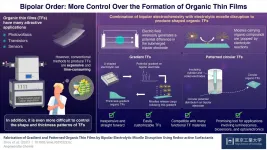(Press-News.org) When a person views a familiar image, even having seen it just once before for a few seconds, something unique happens in the human brain.
Until recently, neuroscientists believed that vigorous activity in a visual part of the brain called the inferotemporal (IT) cortex meant the person was looking at something novel, like the face of a stranger or a never-before-seen painting. Less IT cortex activity, on the other hand, indicated familiarity.
But something about that theory, called repetition suppression, didn't hold up for University of Pennsylvania neuroscientist Nicole Rust. "Different images produce different amounts of activation even when they are all novel," says Rust, an associate professor in the Department of Psychology. Beyond that, other factors—an image's brightness, for instance, or its contrast—result in a similar effect.
In a paper published in the Proceedings of the National Academy of Sciences, she and postdoctoral fellow Vahid Mehrpour, along with Penn research associate Travis Meyer and Eero Simoncelli of New York University, propose a new theory, one in which the brain understands the level of activation expected from a sensory input and corrects for it, leaving behind the signal for familiarity. They call it sensory referenced suppression.
The visual system
Rust's lab focuses on systems and computational neuroscience, which combines measurements of neural activity and mathematical modeling to figure out what's happening in the brain. One aspect relates to the visual system. "The big central problem of vision is how to get the information from the world into our heads in an interpretable way. We know that our sensory systems have to break it down," she says.
It's a complicated process, greatly simplified here for clarity: Information comes into the eye via the rods and cones. It travels neuron by neuron through a stack of brain areas that make up the visual system and finally to a visual brain area called the IT cortex. Its 16 million neurons activate in different patterns depending on what's being viewed, and the brain must then interpret the patterns to understand what it's seeing.
"You get one pattern for a specific face. You get a different pattern for 'coffee cup.' You get a different pattern for 'pencil,'" Rust says. "That's what the visual system does. It builds the world back up to help you decipher what you're looking at."
In addition to its role in vision, activation of the IT cortex is also thought to play a role in memory. Repetition suppression, the old theory, relies on the idea that there's an activation threshold that gets crossed: More neural activity tells the brain the image is novel, less indicates one that's previously seen.
Because several factors affect the total amount of neural activity, also called spikes, in the IT cortex, the brain can't discern what's specifically causing the reaction. It could be memory, image contrast, or something else altogether, Mehrpour says. "We propose a new idea that the brain corrects for the changes caused by these other factors, in our case contrast," he says. After that calibration, what remains is the isolated brain activation for familiarity. In other words, the brain understands when it is viewing something that it has previously seen.
Long-term implications
To draw this conclusion, the researchers presented sequences of grayscale images to two adult male rhesus macaques. Every image appeared exactly twice, the first time as novel, the second time as familiar, in a range of high- and low-contrast combinations. Each viewing lasted precisely half a second. The animals were trained to use eye movements to indicate whether an image was new or familiar, disregarding the contrast levels.
As the macaques performed this memory task, the researchers recorded neural activity in the IT cortex, measuring the spikes for hundreds of individual neurons, a unique method that differs from those that measure proxies of neural activity averaged across 10,000 neurons firing. Because Rust and colleagues wanted to understand the neural code, they needed information for individual neurons.
Using a mathematical approach, they deciphered the patterns of spikes that accounted for how the macaques could distinguish memory from contrast. This ultimately confirmed their hypothesis. "Familiarity and contrast both change the overall firing rate," Rust says. "What we're saying is the brain can tease apart and isolate one from the other."
In the future, better understanding this process could have applications for artificial intelligence, Mehrpour says. "If we know how the brain represents and rebuilds information in memory in the presence of changes in sensory input like contrast, we can design AI systems that work in the same way," he says. "We could potentially build machines that work in the same way that our brain does."
Beyond that, Rust says that down the line the findings could have implications for treating memory-impairing diseases like Alzheimer's. "By understanding how memory in a healthy brain works, you can lay the foundations to develop preventions and treatments for the memory-related disorders plaguing an aging population."
But for any of this to come to pass, it will be crucial to keep digging, she says. "To get this right, we have to understand the memory signal that's driving behavior." This work brings neuroscientists one step closer.
INFORMATION:
Funding for this research came from the Simons Foundation (grants 543033 and 543047), National Eye Institute of the National Institutes of Health (Grant R01EY020851), National Science Foundation (CAREER Award 1265480), and Howard Hughes Medical Institute.
Vahid Mehrpour is a postdoctoral fellow in the Visual Memory Lab at the University of Pennsylvania.
Travis Meyer is a research associate in the Visual Memory Lab at the University of Pennsylvania.
Nicole Rust is an associate professor in the Department of Psychology in the School of Arts & Sciences at the University of Pennsylvania. She is also director of the Visual Memory Lab, co-director of the Computational Neuroscience Initiative, and MindCORE's executive director for research.
Eero Simonelli is a professor of neural science, mathematics, data science, and psychology in the College of Arts & Science at New York University. He is also founding director of the Center for Computational Neuroscience at the Simons Foundation's Flatiron Institute.
The combination of a carb-heavy diet and poor oral hygiene can leave children with early childhood caries (ECC), a severe form of dental decay that can have a lasting impact on their oral and overall health.
A few years ago, scientists from Penn's School of Dental Medicine found that the dental plaque that gives rise to ECC is composed of both a bacterial species, Streptococcus mutans, and a fungus, Candida albicans. The two form a sticky symbiosis, known scientifically as a biofilm, that becomes extremely virulent and difficult to displace from the tooth surface.
Now, a new study from the group offers a strategy for disrupting this biofilm by targeting the yeast-bacterial interactions ...
In studying COVID-19 testing and positivity rates in West Virginia between March and September 2020, West Virginia University researchers found disparities among Black residents and residents experiencing food insecurity.
Specifically, the researchers found communities with a higher Black population had testing rates six times lower than the state average, which they argue could potentially obscure prevalence estimates. They also found that areas associated with food insecurity had higher levels of testing and a higher rate of positivity.
"This could mean that public health officials are targeting predominately rural areas to keep tabs on how the pandemic will unfold in isolated communities within higher food insecurity," said Brian Hendricks, a research assistant professor with ...
Australian scientists have compared an ancient Greek technique of memorising data to an even older technique from Aboriginal culture, using students in a rural medical school.
The study found that students using a technique called memory palace in which students memorised facts by placinthem into a memory blueprint of the childhood home, allowing them to revisit certain rooms to recapture that data. Another group of students were taught a technique developed by Australian Aboriginal people over more than 50,000 years of living in a custodial relationship with the Australian land.
The ...
Researchers at Michigan Medicine found that people with venom allergies are much more likely to suffer mastocytosis, a bone marrow disorder that causes higher risk of fatal reactions.
The team of allergists examined approximately 27 million United States patients through an insurance database - easily becoming the nation's largest study of allergies to bee and wasp stings, or hymenoptera venom. The results, published in the Journal of Allergy and Clinical Immunology, revealed mastocytosis in fewer than 0.1% of venom allergy patients - still near 10 times higher than those without allergies.
"Even though there is mounting interest, mast cell diseases are quite understudied; ...
Modern and emerging applications in various fields have found creative uses for organic thin films (TFs); some prominent examples include sensors, photovoltaic systems, transistors, and optoelectronics. However, the methods currently available for producing TFs, such as chemical vapor deposition, are expensive and time-consuming, and often require highly controlled conditions. As one would expect, making TFs with specific shapes or thickness distributions is even more challenging. Because unlocking this customizability could spur advances in many sophisticated applications, researchers are actively exploring new approaches for ...
In quiet moments, the brain likes to wander—to the events of tomorrow, an unpaid bill, an upcoming vacation.
Despite little external stimulation in these instances, a part of the brain called the default mode network (DMN) is hard at work. "These regions seem to be active when people aren't asked to do anything in particular, as opposed to being asked to do something cognitively," says Penn neuroscientist Joseph Kable.
Though the field has long suspected that this neural network plays a role in imagining the future, precisely how it works hadn't been fully understood. Now, research from Kable and two former graduate students in his lab, Trishala Parthasarathi, associate director of scientific services at OrtleyBio, and Sangil Lee, a postdoc at University of California, ...
SAN DIEGO (May TK, 2021) - Compared to most other bear species, very little is known about how female Andean bears choose where they give birth to cubs. As a critical component of the reproductive cycle, birthing dens are essential to the survival of South America's only bear species, listed as Vulnerable on the International Union for Conservation of Nature (IUCN) Red List of Threatened Species.
A new study led by Russ Van Horn, Ph.D., published April in the journal Ursus, takes the most detailed look yet at the dens of this species. Van Horn, a population sustainability scientist, leads San Diego Zoo Wildlife Alliance's Andean bear conservation program. He was joined by colleagues from the University of British Columbia's Department of Forest ...
A large survey of women in California shows significant racial and ethnic differences in the types of personal care products women use on a daily basis. Because many personal care products contain endocrine disrupting chemicals (EDCs) like parabens and phthalates that interfere with the body's hormones, the findings could shed light on how different products influence women's exposures to harmful chemicals that contribute to health inequities.
The study appears in the Journal of Exposure Science & Environmental Epidemiology as part of a special issue focused on health equity. ...
In the midst of a devastating global pandemic of wildlife origin and with future spillovers imminent as humans continue to come into closer contact with wildlife, infectious-disease models that consider the full ecological and anthropological contexts of disease transmission are critical to the health of all life. Existing models are limited in their ability to predict disease emergence, since they rarely consider the dynamics of the hosts and ecosystems from which pandemics emerge.
Published May 17 in Nature Ecology and Evolution, Smithsonian scientists and partners provide a framework for a new approach to modeling infectious diseases. It adapts established methods developed to study the planet's natural systems, including ...
LA JOLLA--(MAY 18, 2021) Despite only accounting for about 1 percent of skin cancers, melanoma causes the majority of skin cancer-related deaths. While treatments for this serious disease do exist, these drugs can vary in effectiveness depending on the individual.
A Salk study published on May 18, 2021, in the journal Cell Reports reveals new insights about a protein called CRTC3, a genetic switch that could potentially be targeted to develop new treatments for melanoma by keeping the switch turned off.
"We've been able to correlate the activity of this genetic switch to melanin production and cancer," says Salk study ...


